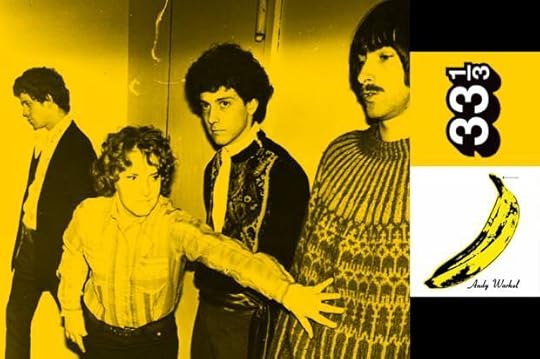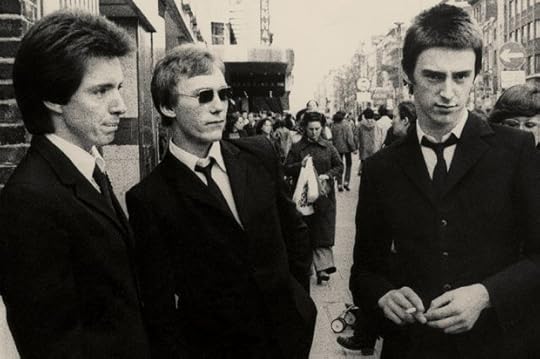Helen H. Moore's Blog, page 236
November 18, 2017
Andy Warhol, record producer: capturing the sonic attack of The Velvet Underground

(Credit: Wikipedia/Bloomsbury Publishing/Salon)
In hands-on terms [John] Cale has said, “Andy Warhol didn’t do anything.” Warhol’s unique style might disqualify him from the title of “producer” at all, making him effectively an executive producer. But Warhol’s role, and his effect as producer cannot be denied. You could say he produced the producers as well as the band. Longtime friend of the band, rock manager and A&R legend Danny Fields spoke eloquently on the subject in “Uptight: The Velvet Underground Story”:
Andy doesn’t know how to translate ideas into musical terms . . . Andy . . . was making them sound like he knew they sounded at the Factory. That’s what I would do if I were an amateur at production . . . What Andy did was very generously reproduce . . . the way it sounded to him when he first fell in love with it.
The group had their sound together before meeting Warhol. They had Lou Reed’s experience at Pickwick [Records] to prepare them for the studio’s technical challenges, and the good fortune to luck into [Norman] Dolph and [John] Licata at the right moment. In Los Angeles fortune smiled again, and they added Tom Wilson’s expertise as well. So there was no need at all for Warhol to be a knob twiddler—which he clearly wasn’t.
Reed: Andy was the producer and Andy was in fact behind the board gazing with rapt fascination . . .
Cale: . . . at all the blinking lights.
Reed: . . . At all the blinking lights. He just made it possible for us to be ourselves and go right ahead with it because he was Andy Warhol. In a sense he really did produce it, because he was this umbrella that absorbed all the attacks when we weren’t large enough to be attacked . . . as a consequence of him being the producer, we’d just walk in and set up and do what we always did and no one would stop it because Andy was the producer. Of course he didn’t know anything about record production—but he didn’t have to. He just sat there and said “Oooh, that’s fantastic,” and the engineer would say, “Oh yeah! Right! It is fantastic, isn’t it?”
This alone made Warhol indispensable to the album. But, of course, he did more than that. Fricke calls Warhol “a specialist in subtly engineered collisions of people and ideas,’ and in that role Warhol (with help from Paul Morrissey) coaxed the group into accepting Nico as a vocalist, completing the chemistry that makes the album so amazing. He was also the umbrella under which Dolph in New York and Wilson in LA (and later New York) worked, unfettered by label interference. And he got the album heard, for even if Dolph and Wilson had done brilliant work, without the carte blanche Warhol provided it’s doubtful the recording would have made it onto vinyl. Thus, Warhol did precisely what a great producer should: he achieved an effective translation of the sound that the band heard in their heads on to tape, and then he got it out into the world in tact.
A trade-off of Warhol’s inexperience in the studio could have been a disastrous loss in Sonic clarity. Cale also claimed that Norman Dolph “didn’t understand the first f**king thing about recording . . . he didn’t know what the hell he had on his hands,’ and while Dolph didn’t dispute the charges (he responds “nobody knew what they were doing”), I think Cale’s criticism is way off the mark. First of all, with Cale filling the role of creative producer without portfolio, Dolph says:
I never felt I had the authority to pick takes, or veto them—that, to me, was clearly up to Cale, Reed and Morrison . . . Lou Reed was more the one who’d say “this needs to be a little hotter,” he made decisions about technical things . . . and the mixing was really between Cale, Sterling and John Licata, ’cause that was all, again, done in real time.
As for sound quality, over-saturated tapes caused some audible distortion, and noise from less-than-perfect overdubs is also in evidence. But considering the unprecedented Sonic attack in songs like “European Son” and “Black Angel’s Death Song,” which few engineers would have been comfortable capturing (or tolerating) in 1966, you have to agree that the Dolph-Licata team performed brilliantly. Any doubts on that score can be dispelled with a few “this is what might have been” moments of comparative listening to Reed’s primitive-sounding Pickwick recordings, which aren’t even in the same ballpark as Licata’s engineering work. And any noise/distortion issues on the LP detract little from the overall listening experience. Moreover, the band happily accepted these slight technical shortfalls at the time, and-whether by their own design or Warhol’s—band and producer shared an aesthetic that made errors part of the modus operandi. Reed noted:
No one wants it to sound professional. It’s so much nicer to play into one very cheap mike. That’s the way it sounds when you hear it live and that’s the way it should sound on the record.
Warhol elaborated:
I was worried that it would all come out sounding too professional . . . one of the things that was so great about them was they always sounded so raw and crude. Raw and crude was the way I liked our movies to look, and there’s a similarity between sound in that album and the texture of “Chelsea Girls,” which came out at the same time.
The studio approach they took, as recalled by Dolph, left little threat of things sounding too professional:
From a take-wise point of view you weren’t presented with many options. They either got it right, or broke down, or did a couple of takes; but it wasn’t as though you got 17 takes . . . either you chose this one or you chose that one and then you went on and did the next one. Usually they’d do a piece of one and then come in and listen to it. If one got largely through and it broke down, they’d come in and listen to it and say “yeah that sounds like we got it right”; or, if one got all the way through, they’d come in and either buy it, or adjust the mix or do it again. But there were not a whole lot of complete takes.
The strange story of turkey tails speaks volumes about our globalized food system

(Credit: AP Photo/Danny Johnston, File)
Intensive livestock farming is a huge global industry that serves up millions of tons of beef, pork and poultry every year. When I asked one producer recently to name something his industry thinks about that consumers don’t, he replied, “Beaks and butts.” This was his shorthand for animal parts that consumers — especially in wealthy nations — don’t choose to eat.
On Thanksgiving, turkeys will adorn close to 90 percent of U.S. dinner tables. But one part of the bird never makes it to the groaning board, or even to the giblet bag: the tail. The fate of this fatty chunk of meat shows us the bizarre inner workings of our global food system, where eating more of one food produces less-desirable cuts and parts. This then creates demand elsewhere — so successfully in some instances that the foreign part becomes, over time, a national delicacy.
Spare parts
Industrial-scale livestock production evolved after Word War II, supported by scientific advances such as antibiotics, growth hormones and, in the case of the turkey, artificial insemination. (The bigger the tom, the harder it is for him to do what he’s supposed to do: procreate.)
U.S. commercial turkey production increased from 16 million pounds in January 1960 to 500 million pounds in January 2017. Total production this year is projected at 245 million birds.
That includes a quarter-billion turkey tails, also known as the parson’s nose, pope’s nose or sultan’s nose. The tail is actually a gland that attaches the turkey’s feathers to its body. It is filled with oil that the bird uses to preen itself, so about 75 percent of its calories come from fat.
It’s not clear why turkeys arrive at U.S. stores tailless. Industry insiders have suggested to me that it may simply have been an economic decision. Turkey consumption was a novelty for most consumers before World War II, so few developed a taste for the tail, although the curious can find recipes online. Turkeys have become larger, averaging around 30 pounds today compared to 13 pounds in the 1930s. We’ve also been breeding for breast size, due to the American love affair with white meat: One prized early big-breasted variety was call Bronze Mae West. Yet the tail remains.
Savored in Samoa
Rather than letting turkey tails go to waste, the poultry industry saw a business opportunity. The target: Pacific Island communities, where animal protein was scarce. In the 1950s U.S. poultry firms began dumping turkey tails, along with chicken backs, into markets in Samoa. (Not to be outdone, New Zealand and Australia exported “mutton flaps,” also known as sheep bellies, to the Pacific Islands.) With this strategy, the turkey industry turned waste into gold.
By 2007 the average Samoan was consuming more than 44 pounds of turkey tails every year – a food that had been unknown there less than a century earlier. That’s nearly triple Americans’ annual per capita turkey consumption.
When I interviewed Samoans recently for my book “No One Eats Alone: Food as a Social Enterprise,” it was immediately clear that some considered this once-foreign food part of their island’s national cuisine. When I asked them to list popular “Samoan foods,” multiple people mentioned turkey tails — frequently washed down with a cold Budweiser.
How did imported turkey tails become a favorite among Samoa’s working class? Here lies a lesson for health educators: The tastes of iconic foods cannot be separated from the environments in which they are eaten. The more convivial the atmosphere, the more likely people will be to have positive associations with the food.
Food companies have known this for generations. It’s why Coca-Cola has been ubiquitous in baseball parks for more than a century, and why many McDonald’s have PlayPlaces. It also explains our attachment to turkey and other classics at Thanksgiving. The holidays can be stressful, but they also are a lot of fun.
As Julia, a 20-something Samoan, explained to me, “You have to understand that we eat turkey tails at home with family. It’s a social food, not something you’ll eat when you’re alone.”
Turkey tails also come up in discussions of the health epidemic gripping these islands. American Samoa has an obesity rate of 75 percent. Samoan officials grew so concerned that they banned turkey tail imports in 2007.
But asking Samoans to abandon this cherished food overlooked its deep social attachments. Moreover, under World Trade Organization rules, countries and territories generally cannot unilaterally ban the import of commodities unless there are proven public health reasons for doing so. Samoa was forced to lift its ban in 2013 as a condition of joining the WTO, notwithstanding its health worries.
Author Michael Carolan cooks turkey tails for the first time.
Embracing the whole animal
If Americans were more interested in eating turkey tails, some of our supply might stay at home. Can we bring back so called nose-to-tail animal consumption? This trend has gaining some ground in the United States, but mainly in a narrow foodie niche.
Beyond Americans’ general squeamishness toward offal and tails, we have a knowledge problem. Who even knows how to carve a turkey anymore? Challenging diners to select, prepare and eat whole animals is a pretty big ask.
Google’s digitization of old cookbooks shows us that it wasn’t always so. “The American Home Cook Book,” published in 1864, instructs readers when choosing lamb to “observe the neck vein in the fore quarter, which should be of an azure-blue to denote quality and sweetness.” Or when selecting venison, “pass a knife along the bones of the haunches of the shoulders; if it smell [sic] sweet, the meat is new and good; if tainted, the fleshy parts of the side will look discolored, and the darker in proportion to its staleness.” Clearly, our ancestors knew food very differently than we do today.
It is not that we don’t know how to judge quality anymore. But the yardstick we use is calibrated — intentionally, as I’ve learned — against a different standard. The modern industrial food system has trained consumers to prioritize quantity and convenience, and to judge freshness based on sell-by-date stickers. Food that is processed and sold in convenient portions takes a lot of the thinking process out of eating.
 If this picture is bothersome, think about taking steps to recalibrate that yardstick. Maybe add a few heirloom ingredients to beloved holiday dishes and talk about what makes them special, perhaps while showing the kids how to judge a fruit or vegetable’s ripeness. Or even roast some turkey tails.
If this picture is bothersome, think about taking steps to recalibrate that yardstick. Maybe add a few heirloom ingredients to beloved holiday dishes and talk about what makes them special, perhaps while showing the kids how to judge a fruit or vegetable’s ripeness. Or even roast some turkey tails.
Michael Carolan, Professor of Sociology and Associate Dean for Research, College of Liberal Arts, Colorado State University
Fox Business host savaged for claiming “there are no allegations against” Trump

Fox Business host Maria Bartiromo made the claim on Friday that “there are no allegations” against President Donald Trump, despite him facing accusations from at least 16 women who all have said he sexually harassed them, or engaged in inappropriate conduct.
In a panel discussion Bartiromo and her guests were ripping into Sen. Al Franken, D-Minn., who was accused of groping and forcing a kiss on radio host Leeann Tweeded during a USO tour in 2006.
Bartiromo then asked one of her guests, Christopher Lu, the former assistant to President Obama, whether or not he agreed with Sen. Kirsten Gillibrand, D-N.Y., who recently said that former President Bill Clinton should have resigned when his inappropriate relationship with intern Monica Lewinsky surfaced.
Lu explained that Clinton would have likely been “seen under a different political lens” if it had come up in the current environment.
“We say that” different standards would be applied today for Clinton, Lu argued, but he also pointed out that the infamous Access Hollywood tape about President Donald Trump, and the allegations against Alabama Senate candidate Roy Moore, have surfaced.
“You need to look at this all in a whole,” Lu said. “How do you measure allegations with a photo versus allegations involving a yearbook? What are the standards when you’re looking at a political election versus legal proceedings.”
“What do you mean how do you differentiate?” Bartiromo shot back. “There’s a picture [of Franken].”
Lu pointed out that there are several allegations against Moore and “probably an equal number that have made allegations against the president.”
“So if they deny the allegations, yet you have other evidence and you have their testimony — I’m inclined to believe all of the womens’ testimonies,” Lu said.
“Just to be clear, there are no allegations against the president,” Bartiromo claimed.
After Lu clarified that the allegations were from before he was elected president, Bartiromo argued, “He said during the campaign that wasn’t true. In fact, didn’t he say also that, you know, all of this will come to light and there will be a lawsuit? I mean… we’re talking about a situation where we have a picture with the guy’s hands on her breasts. You can’t compare the two, Chris.”
Bartiromo insisted “it’s not the same at all” and it’s like comparing “apples to oranges.”
After the segment CNN’s Brian Stelter tweeted that what Bartiromo said was “really strange” considering numerous women have alleged Trump engaged in misconduct. Bartiromo then blocked Stelter on Twitter, according to screenshots he published.
I’ve always had a cordial relationship with @MariaBartiromo. I can only assume that this tweeted observation is why she suddenly blocked me… ♂️ pic.twitter.com/p6PEGTiBGk
— Brian Stelter (@brianstelter) November 18, 2017
She also blocked Huffington Post journalist Yashar, who tweeted that the Fox Business host had “just erased sixteen women.”
3. Wow @brianstelter she blocked me too after my two tweets above. pic.twitter.com/7gmtpLMcBj — Yashar Ali (@yashar) November 18, 2017
It’s not clear if her blocking spree continued, but she sure felt the wrath of the Twitter mob.
So much gaslighting, it’s a wonder @ChrisLu44 survived the carbon monoxide poisoning. (@MariaBartiromo, girl. What has happened to you.) https://t.co/QaUs9UONLb
— shauna (@goldengateblond) November 18, 2017
I remember when Maria Bartiromo was considered a serious journalist. Would love to see her bring her nonsense and state tv sensibility to 4 pm on MSNBC — Steve Schmidt (@SteveSchmidtSES) November 18, 2017
According to Sarah Sanders (and Maria Bartiromo) sexual assault allegations don’t count if you deny them. So it’s all good. https://t.co/QLk0bMctru
— Joe Remi (@JosephRemiB) November 18, 2017
Didn’t @MariaBartiromo used to be a journalist? https://t.co/7N7VskAnet — Reza Aslan (@rezaaslan) November 18, 2017
Ha! @MariaBartiromo blocked me on Twitter after I ripped her inane criticism of @NFL protests and Colin @Kaepernick7. Maria, when some media folks get on your nerves, just do what I do: ignore them. Or mute them. Blocking is just weak. https://t.co/hwPTBUTXpn
— rolandsmartin (@rolandsmartin) November 18, 2017
Crazy – uh – and what did u say about me? https://t.co/H1kgQiXKo6 — Gretchen Carlson (@GretchenCarlson) November 18, 2017
A reminder that at least 15 women have accused Donald Trump on the record of unwanted physical contact. Listen for the patterns in their stories. #inners pic.twitter.com/thoTR3OyXv
— All In w/Chris Hayes (@allinwithchris) November 18, 2017
Watch the full segment below:
To prevent climate-related disasters, invest differently

A man walks past a house laying in flood water in Catano town, in Juana Matos, Puerto Rico after Hurricane Maria (Credit: Getty/Hector Retamal)
A major blackout hit Puerto Rico’s most populated region last week, deepening the recovery crisis that has plagued the U.S. Commonwealth since Hurricane Maria hit almost two months ago.
As Maria — as well as recent disasters in Houston, Florida and northern California — have reminded us, nature is a very fickle, but also dependable force. As human beings we largely reap what we sow. Over the past 200 years, we have invested the world’s financial resources into production processes and energy sources that have caused disruption to the planet. Scientific consensus is that this has led to the intensification of natural disasters globally.
To try and addressed the damage we have caused, philanthropy has emerged as a counterforce to climate change. As Americans, we gave away $11 billion in 2016 to environmental and animal welfare organizations. This is fantastic, but it’s truly pocket change compared to the $40 trillion that circulates in the global economy every day — not to mention the close to $5 trillion represented by the market cap of publicly held fossil fuel companies. If we care about the future of our planet and want to break out of this David and Goliath fight — where philanthropy is trying to clean up the messes that the global economy has caused — we need to fundamentally change the economy, starting with the way that we invest.
How do we do this? Over the past decade, the practice of impact investment — investing dollars in a way that’s aligned with the social and environmental future we’d like to see — has become increasingly accessible. Major investors such as pension funds, endowments and foundations, are investing in innovations from wind energy to worker-owned cooperatives. And every day people are choosing to break up with their bank and seek out the local credit union or environmental bank that better reflects their values. They can also hold institutions accountable that are investing on their behalf — from that perspective we all have billions of dollars of economic influence to address climate change and just need to take advantage of that incredible opportunity to influence positive change.
But largely, social investing is still the trillion dollar trend most people have never heard of. We think finance is messy and complicated (and especially scary when our resources are running low) and try to ignore it. We might care deeply about the environment and worry about climate change, but not realize that our mutual fund is invested in fossil fuel companies. While many of us feel we lack economic power to make change, we forget that most financial institutions are accountable to the public in some way.
Are you a teacher? Check out where your pension fund is invested — if you’re lucky, it’s with a group like CALSTRS that has taken a proactive stance on climate change. Did you go to college? When they ask you to write that donation check, ask them how that money is going to be invested and if it’s in line with the future that you want to build. More than 100 educational institutions, like Stanford and the London School of Economics, have already divested from fossil fuels in some form; many could still be more proactive. Take control of your bank account and your financial relationships, and learn to become a conscious consumer of not just your fair-trade coffee and cage-free eggs but your financial investments as well, when choosing a 401(k), a mutual fund or just deciding where to store your cash.
Impact investment is a great trend, and it’s becoming widespread and easy enough that, for instance, in the case of retirement funds, you can often just check the social box when you get the application. But it’s still part of the traditional financial system — and that means it’s not a system-changing panacea. Most of these funds focus on screening out the worst offenders, when really we need to put more energy into funding viable alternatives such as clean energy. And we need to do so in a way that centers on social justice — making sure the clean energy transition builds wealth not just for historic actors but for women and people of color as well.
If we continue to invest in the status quo of environmental destruction, we can’t be surprised when it’s time to reap what we sow. But if we can invest in a clear energy future in a way that distributes wealth and power in the process, then we might be getting somewhere.
November 17, 2017
Trump lies 9 times a day on average lately

Donald Trump points to the sun as he arrives to view the solar eclipse. (Credit: AP/Andrew Harnik)
As of 3am Eastern Standard Time on Tuesday, Donald Trump has told 1,628 lies since taking office. We know this because the Washington Post has been diligently watching the numbers, keeping tabs on Trump’s huge fibs and falsehoods. Over the 298 days since his inauguration, Trump has told an average of 5.5 lies every single day of the week, Monday to Sunday. While he barely works weekdays and golfs every weekend, he apparently never takes a vacation from lying.
Over the last 35 days, Trump has been even more dishonest than usual, upping his daily average to 9 lies every 24 hours. Thanks to the extra effort he’s put into misleading the country on a diversity of topics in recent weeks, he’s likely to reach “peak liar” status by January 20. “That puts the president on track to reach 1,999 claims by the end of his first year in office, though he obviously would easily exceed 2,000 if he maintained the pace of the past month,” the Post notes.
Trump tends to lie about the same things over and over again. Near the top of his greatest hits are taxes. Trump falsely stated 40 times that GOP tax reform will yield the biggest tax cut in history, and 50 times erroneously suggested the U.S. is the highest taxed nation in the world. Fifty-five times Trump has boasted about achievements he played no part in, especially when it comes to saving or creating jobs. But Trump has lied about Obamacare more than any other topic, stating some 60 times “some variation of the statement that the Affordable Care Act is dying and ‘essentially dead,’” according to the Post. That is just not true. “Indeed, healthy enrollment for the coming year has surprised health-care experts,” according to the outlet.
Trump’s lies are dangerous for reasons many have acknowledged. Obviously, the spread of misinformation and disinformation and the obliteration of truth may hold deep consequences for society and our already flawed democracy. All politicians lie, but Trump lies habitually, and with alarming frequency. The only surprise about Trump’s lying at this point is what he chooses to lie about — how easily disprovable his lies are and how unconvincing he is after so much practice. Of course, that matters little to Trump’s base and the GOP overall, for whom whataboutism and “if true”-ism are perfectly good stand-ins for what we’re constantly told are traditional values and morals.
Get early Black Friday pricing on your new favorite wireless earbuds

While wireless listening might be the new standard, so many pairs are incredibly finicky to use: either they’re not truly wireless (still relying on a cord to hold themselves in place), constantly fall out from your ears in the middle of a workout, or need to work paired together in order to even function. Well, say goodbye to subpar wireless buds and hello to your new favorite pair: these TREBLAB X11 Earbuds.
The TREBLAB X11’s are small, discreet and deliver incredible, crisp audio. They’re truly wireless buds — meaning absolutely no wires whatsoever — and employ elite Bluetooth audio technology to deliver lag-free sound whether you’re taking a call or streaming your playlist. And with passive noise cancellation and a built-in mic, you’ll be able to tune in with perfect fidelity — no struggling to hear conference call details or your favorite band’s latest song over the sounds of the outside world.
Not only do these buds support multiple device connections, you can use them as a single earpiece or paired together. Plus, the secure ear fins give you truly wireless, sweat-proof flexibility for any activity, whether you’re running at the gym or just running late to the office.
Give yourself the listening experience you deserve: usually these TREBLAB X11 Earbuds for $199.99, but you can get them now for $36.99, or 81% off the usual price.
You’ll want to turn in early with these silky bamboo sheets

The fact that it’s getting darker earlier and earlier could be a bummer — unless you’re looking forward to snuggling up at night with this Ultra Soft 1800 Series Bamboo Bed Sheet Set. Made out of a mixture of high-quality bamboo yarns and high-strength microfiber, this is just the bedding upgrade you need to actually want to turn in early and set an alarm for later.

You know that luxurious feeling you get when you stay at a nice hotel and the sheets are wonderfully soft and fresh? Now you can get the same feeling right in the comfort of your own home. Made out of bamboo yarns, these sheets have been mercerized and pre-shrunk to stay soft and wrinkle-free for a long time. And unlike other sheets that lose their shape, these stay crisp, lending a little extra polish to your bedroom decor.

The set comes with one flat sheet, one fitted sheet and two pillowcases for your snoozing pleasure — and the fitted sheet will fit even extra thick mattresses with an all-around elastic design and deep pockets.
Get the wonderful night’s sleep you deserve — this Ultra Soft 1800 Series Bamboo Bed Sheet Set comes in three colors, including:
Grey
White
Ivory
Usually this set is $49.99, but you can get all of them now for $29.99, or 40% off the original price. For a limited time only, use the code: GIFTSHOP15 for an additional 15% off!
Charge your device in over 150 countries with this tiny travel adapter

One of the worst things about traveling anywhere internationally? Needing to use your device to coordinate travel or meet with a friend — and realizing you’re not only at low battery, but the adapter you’ve brought with you isn’t compatible with the country you’re in. This holiday season, be prepared with this OMNIA Travel Adapter.
This is the world’s smallest travel adapter, but it still manages to pack a ton of functionality into a compact design. It’s fully ready to charge your device in more than 150 countries, without you needing to lug a whole bunch of different cables and adapters around. Instead, just use the efficient sliding design to lock the proper plug into place.
This clever device supports charging for any iOS or Android smartphone or tablet, helping you save space for your carry-on — plus, the 5-in-1 interface supports US/UK/EU/AU and USB-A standards. And you’ll never need to worry about your devices frizzing out: USB BC1.2 Intelligent Chipset Standard protects USB charging, while the built-in LED charging light indicates charging status.
Prepare for holiday travel: usually this OMNIA Travel Adapter is $49, but you can get it now for $39.99. You can also save an additional 15% off with coupon code GIFTSHOP15.
Can’t stop jamming

The Jam (Credit: Polydor)
We’re all familiar with a film considered so bad that it’s good, but what of a rock and roll band so indicative of an era that it necessarily has to come from another one? That question strikes me as the root theme of both Universal’s rabblerousing new Jam box set, 1977, and the band’s very legacy.
First matters: there have been a lot of Jam box sets lately, and if they’re one of your favorite bands, you must be in manna land these days. Others will cite overkill and complain about who has the time to tour the dustbin dossier of a mod band from the late 1970s, while likely listening to crappy music in the stead of stuff like this. Because, frankly, the Jam were awesome, even if they always felt, given their era and what we remember of said era, off-kilter with rock’s thru-line and where a band like this one should have happened in it — like, say, 1965-1966, right after rock and roll got smart, and prior to psychedelia.
The year 1977 was year one so far as Jam-dom went, with Paul Weller and crew releasing two albums, the debut “In the City” and sophomore outing “This is the Modern World.” Both, of course, are included on this set, which is putting forth an argument — and these kinds are always fun to debate — that in 1977 the Jam had one of the best years any rock artist ever has.
Some other contenders for that list: the Beatles in ’63, Dylan in ’66, Elvis in ’54, Hendrix in ’67. To qualify, you need a lot of material, you probably need to kick ass on a great run of gigs, a couple all-timer albums are useful, and toss in some landmark radio/TV appearances, plus it wouldn’t hurt if you tweak the musical and cultural zeitgeist in some way as you’re launching your career/art into the exosphere.
Those first two Jam albums were admirably peppery. It’s as if Jimmy, the central character from the Who’s mod rock opera, “Quadrophenia,” took on life as bookending pieces of vinyl. A mod was short for modernist, with their glory cultural run happening in Britain’s early and mid-1960s. They loved scooters and long, long coats, pills and Tamla soul. They were the rivals of the more famous teddy boys, the throwback rockers to the Elvis, Jerry Lee, Gene Vincent era, who are remembered more today because the Beatles once dressed like them when they were but four dots in Fame’s eye.
The early Jam espoused this mod aesthetic, despite occurring more than a decade after the fact, and I think that has dogged them somewhat when we talk about the best bands. That’s why these reissues can be handy, as they take us back into Paul Weller’s songwriting. He was a tauter version, as a songwriter, than Noel Gallagher, almost two decades before the fact, with a lot of Ray Davies in him, far more than the Who’s Pete Townshend, who is often cited as a Weller forerunner.
Davies and the Kinks had a brief flirtation with nascent metal (“You Really Got Me,” “All Day and All of the Night,” “I Need You”) before ditching that for the world of ideas and observations, where what was glimpsed at a subway stop, which no one else would have even noticed, became the root of a romance that could feel timeless and Chaucerian. Era-less. Also, almost always tuneful.
Paul Weller was the same way, right from the start of the Jam’s career. The Jam made it sound like both punk and post-punk were happening simultaneously, with a band who were really neither, fleshing out tube station vignettes that became rippling musical tapestries. And goodness how they loved Motown, and could infuse black music into their schema in ways that had other white English quartets and trios executing double-takes.
The Kinks couldn’t do this, the Who tended to sound awkward — albeit manfully so — when they tried in their 1964-65 phase, while the Stones could be adroit and the Beatles often masterful. But if you find that you have a hard time starting your days, let me recommend a blast of “Non-stop Dancing” from “In the City.” That and a cup of coffee will send out onto the streets a veritable bouncy beast, primed to kick ass at that morning meeting you were worried about.
As with the Who, so much of the Jam’s early sound is built up from the rhythm guitar, and you can’t over-emphasize that notion of tautness. There is great tensile strength in songs like “I’ve Changed My Address” from the debut and the title track of the follow-up. Parts feel stretched like a steel wire, but with that wire covering a short distance, all of the energy centered on the traversal of points A to B.
It takes some serious balls to mix black rhythm and blues with English white boy rock like this. I despair when I wonder if anyone with the requisite chops would even try to today, for fear of getting branded a cultural appropriation goon. Then again, if you dropped the Jam in the here and now, I don’t think they’d care.
Genius, I have learned, does not sit around and wait for the most favorable epoch; genius gets on with it, in whatever time period it may be situated. There is always a roost, let us say — and when there is genius, there always comes a time to rule it, regardless of the specs of said roost.
For the Jam, this was the late 1970s, after Paul Weller had processed all of the music that had come out in that 1965-66 era, which probably had something to do with how he came to write the songs he did and others that he wouldn’t have been interested in writing.
But when you’re smack dab in a time period, controlled filtration doesn’t work so readily. You spend your time processing what is going on around you, because you are there in the valley, rather than up on the butte, surveying. But not so the Jam, who became the perfect 1960s band by existing in another decade, without ever sounding like a pastiche or throwback.
The demos on the box set show how fully formed Weller’s songwriting gift was before the band hit the studio. Demos can be messy, inchoate things, but with the best writers they can match, and sometimes exceed, their eventual full-band counterparts. Pete Townshend’s demo work, as collected on the “Scoop” sets, is a fine example. Weller is in that crowd, but it is the September 10, 1977 show from the Nashville — a London club — that the seasoned Jam buffs will lose their minds over.
Keep in mind: punk was thrashing your brains out in London at this time, and a very exciting time at that. Listen to this gig, though, which is more exciting still, more adrenalized, even, than punk, but so much more meticulously balanced. There is blazing away on stage, and there is whatever the Jam are doing here.
“All Around the World” sounds like a layout plan for this band’s entire career, pitched from a stage. “I said I want a reaction, all over this land,” Weller declares like a deep soul shouter who can’t leave the stage he’s already been up on all night. There’s nothing proselytizing about it. Nor is there anything especially 1977 about it, and it makes me hesitant to say that the perfect embodiment of a 1960s band really belonged in that decade at all. I hear this and it makes me think, well, just give them all the decades, then.
MC Rapsody: Women face double standard in hip-hop

Rapsody (Credit: Peter Cooper)
“It seems like we’re the scapegoats, we’re to blame for all of America’s problems,” Rapsody said of “America’s love/hate relationship with hip-hop,” after an exclusive performance on “Salon Stage.”
Rapsody is a force in the hip-hop world and recently dropped her new album “Laila’s Wisdom” to critical acclaim. She was the only feature artist on Kendrick Lamar’s “To Pimp a Butterfly” in 2015 and has received props and praise from many heavyweights in the industry, including Jay-Z.
Rapsody performed the song “Pay Up” from “Laila’s Wisdom” on “Salon Stage” and discussed the blame hip-hop often bears, women in hip-hop, and an artist’s responsibility to confront the political landscape.
“If we’re talking about guns, violence, sex, misogyny, it’s all pointed back to hip-hop,” Rapsody said. “When in reality, hip-hop is just a reflection of what’s going on in American society. It takes the mirror and holds it back up, it’s like ‘this is you.'”
She also reflected on the double standard in hip-hop where “guys can compete and all be considered greats,” but when it comes to women, artists are constantly compared and forced to compete against each other. Rapsody wants that to change. “It’s important for people to see that, especially black women, that we get along,” she said. “It’s important for young girls to see that.” Further, being a woman in hip-hop can be many things, and “comes in different sizes, styles, shapes, colors,” she said.
Watch the interview above for more on equality in hip-hop and watch the full “Salon Stage” performance on Facebook.
Tune into Salon’s live shows, “Salon Talks” and “Salon Stage,” daily at noon ET / 9 a.m. PT and 4 p.m. ET / 1 p.m. PT, streaming live on Salon and on Facebook.




